Influence of Season and Habitat on the Essential Oils Composition, Allelopathy, and Antioxidant Activities of Artemisia monosperma Delile
Abstract
1. Introduction
2. Materials and Methods
2.1. Study Area
2.2. Soil Sampling and Analysis
2.3. Plant Materials Collection and Preparation
2.4. EOs Extraction, Yielding, and Analysis via GC–MS
2.5. Allelopathic Activity Bioassay
2.6. Antioxidant Activity of A. monosperma EOs
2.7. Statistical Analysis
3. Results and Discussion
3.1. Soil Characteristics of the Studied Regions
3.2. Yielding and Composition of A. monosperma EOs
3.2.1. EOs Profile of A. monosperma Collected from the Ghat Region
3.2.2. EOs Profile of A. monosperma Collected from the Thumamah Region
3.2.3. EOs Profile of A. monosperma Collected from the Giham Region
3.3. Chemometric Analysis of A. monosperma EOs
3.4. Allelopathic Activity of A. monosperma EOs
3.4.1. Ghat Region
3.4.2. Thumamah Region
3.4.3. Giham Region
3.5. Antioxidant Activity of A. monosperma EOs
4. Conclusions
Supplementary Materials
Author Contributions
Funding
Institutional Review Board Statement
Informed Consent Statement
Data Availability Statement
Acknowledgments
Conflicts of Interest
References
- de Oliveira, M.S.; Almeida, M.M.; Salazar, M.; Pires, F.C.S.; Bezerra, F.W.F.; Cunha, V.M.B.; Cordeiro, R.M.; Urbina, G.R.O.; da Silva, M.P.; e Silva, A.P.S. Potential of medicinal use of essential oils from aromatic plants. In Potential of Essential Oils; IntechOpen: London, UK, 2018; pp. 1–21. [Google Scholar]
- Pavela, R.; Benelli, G. Essential oils as ecofriendly biopesticides? Challenges and constraints. Trends Plant Sci. 2016, 21, 1000–1007. [Google Scholar] [CrossRef] [PubMed]
- Ninkovic, V.; Markovic, D.; Rensing, M. Plant volatiles as cues and signals in plant communication. Plant Cell Environ. 2021, 44, 1030–1043. [Google Scholar] [CrossRef]
- Raveau, R.; Fontaine, J.; Lounès-Hadj Sahraoui, A. Essential oils as potential alternative biocontrol products against plant pathogens and weeds: A review. Foods 2020, 9, 365. [Google Scholar] [CrossRef] [PubMed]
- Catani, L.; Grassi, E.; di Montanara, A.C.; Guidi, L.; Sandulli, R.; Manachini, B.; Semprucci, F. Essential oils and their applications in agriculture and agricultural products: A literature analysis through VOSviewer. Biocatal. Agric. Biotechnol. 2022, 45, 102502. [Google Scholar] [CrossRef]
- Valarezo, E.; Aguilera-Sarmiento, R.; Meneses, M.A.; Morocho, V. Study of essential oils from leaves of asteraceae family species Ageratina dendroides and Gynoxys verrucosa. J. Essent. Oil Bear. Plants 2021, 24, 400–407. [Google Scholar] [CrossRef]
- Miguel, M.G. Antioxidant and anti-inflammatory activities of essential oils: A short review. Molecules 2010, 15, 9252–9287. [Google Scholar] [CrossRef] [PubMed]
- Abd-ElGawad, A.M.; El-Amier, Y.A.; Bonanomi, G.; Gendy, A.E.-N.G.E.; Elgorban, A.M.; Alamery, S.F.; Elshamy, A.I. Chemical composition of Kickxia aegyptiaca essential oil and its potential antioxidant and antimicrobial activities. Plants 2022, 11, 594. [Google Scholar] [CrossRef]
- Andrade, M.A.; Braga, M.A.; Cesar, P.H.; Trento, M.V.C.; Espósito, M.A.; Silva, L.F.; Marcussi, S. Anticancer properties of essential oils: An overview. Curr. Cancer Drug Targets 2018, 18, 957–966. [Google Scholar] [CrossRef]
- Hazrati, H.; Saharkhiz, M.J.; Moein, M.; Khoshghalb, H. Phytotoxic effects of several essential oils on two weed species and tomato. Biocatal. Agric. Biotechnol. 2018, 13, 204–212. [Google Scholar] [CrossRef]
- Hijazi, A.M.; Salhab, A.S. Effects of Artemisia monosperma ethanolic leaves extract on implantation, mid-term abortion and parturition of pregnant rats. J. Ethnopharmacol. 2010, 128, 446–451. [Google Scholar] [CrossRef]
- Pandey, A.K.; Singh, P. The genus Artemisia: A 2012–2017 literature review on chemical composition, antimicrobial, insecticidal and antioxidant activities of essential oils. Medicines 2017, 4, 68. [Google Scholar] [CrossRef] [PubMed]
- El Zalabani, S.M.; Tadros, S.H.; El Sayed, A.M.; Daboub, A.A.; Sleem, A.A. Chemical profile and biological activities of essential oil of aerial parts of Artemisia monosperma Del. growing in Libya. Pharmacogn. J. 2017, 9, 578–586. [Google Scholar] [CrossRef]
- Khan, M.; Mousa, A.A.; Syamasundar, K.V.; Alkhathlan, H.Z. Determination of Chemical Constituents of Leaf and Stem Essential Oils of Artemisia monosperma from Central Saudi Arabia. Nat. Prod. Commun. 2012, 7, 1079–1082. [Google Scholar] [CrossRef] [PubMed]
- Abd-ElGawad, A.M.; Elshamy, A.I.; Al-Rowaily, S.L.; El-Amier, Y.A. Habitat affects the chemical profile, allelopathy, and antioxidant properties of essential oils and phenolic enriched extracts of the invasive plant Heliotropium curassavicum. Plants 2019, 8, 482. [Google Scholar] [CrossRef]
- Zhang, T.; Yang, H.; Wen, S.; Qiu, F.; Liu, X. Effects of Harvest season and storage time on the essential oil of the linalool chemotype of Cinnamomum camphora. J. Essent. Oil Bear. Plants 2019, 22, 1379–1385. [Google Scholar] [CrossRef]
- Time and Dates. Climate & Weather Averages in Riyadh, Saudi Arabia. Available online: https://www.timeanddate.com/weather/saudi-arabia/riyadh/climate (accessed on 14 January 2023).
- Belnap, J.; Phillips, S.L.; Miller, M.E. Response of desert biological soil crusts to alterations in precipitation frequency. Oecologia 2004, 141, 306–316. [Google Scholar] [CrossRef]
- Bouyoucos, G.J. Hydrometer method improved for making particle size analyses of soils. Agron. J. 1962, 54, 464–465. [Google Scholar] [CrossRef]
- Jackson, M.L. Soil Chemical Analysis; Constable and Co., Ltd.: London, UK, 1962. [Google Scholar]
- Rowell, D. Soil Science: Methods and Applications; Longman Group: Harlow, UK, 1994. [Google Scholar]
- Allen, S.E.; Grimshaw, H.; Parkinson, J.A.; Quarmby, C. Chemical Analysis of Ecological Materials; Blackwell Scientific Publications: Hoboken, NJ, USA, 1974. [Google Scholar]
- Chaudhary, S.A. Flora of the Kingdom of Saudi Arabia; Ministry of Agriculture and Water: Riyadh, Saudi Arabia, 2000; Volume 2. [Google Scholar]
- Collenette, S. Wildflowers of Saudi Arabia; National Commission for Wildlife Conservation and Development (NCWCD): Riyadh, Saudi Arabia, 1999. [Google Scholar]
- Abd El-Gawad, A.M. Chemical constituents, antioxidant and potential allelopathic effect of the essential oil from the aerial parts of Cullen plicata. Ind. Crops Prod. 2016, 80, 36–41. [Google Scholar] [CrossRef]
- Riaz, S.; Basharat, S.; Ahmad, F.; Hameed, M.; Fatima, S.; Ahmad, M.S.A.; Shah, S.M.R.; Asghar, A.; El-Sheikh, M.A.; Kaushik, P. Dactyloctenium aegyptium (L.) Willd. (Poaceae) differentially responds to pre-and post-emergence herbicides through micro-structural alterations. Agriculture 2022, 12, 1831. [Google Scholar] [CrossRef]
- Macías, F.A.; Castellano, D.; Molinillo, J.M. Search for a standard phytotoxic bioassay for allelochemicals. Selection of standard target species. J. Agric. Food Chem. 2000, 48, 2512–2521. [Google Scholar] [CrossRef]
- Miguel, M.G. Antioxidant activity of medicinal and aromatic plants. Flavour Fragr. J. 2010, 25, 219–312. [Google Scholar] [CrossRef]
- El-Sherei, M.; Khaleel, A.; Motaal, A.A.; Abd-Elbaki, P. Effect of seasonal variation on the composition of the essential oil of Solidago canadensis cultivated in Egypt. J. Essent. Oil Bear. Plants 2014, 17, 891–898. [Google Scholar] [CrossRef]
- Grulova, D.; De Martino, L.; Mancini, E.; Salamon, I.; De Feo, V. Seasonal variability of the main components in essential oil of Mentha× piperita L. J. Sci. Food Agric. 2015, 95, 621–627. [Google Scholar] [CrossRef]
- Amin, S.M.; Hassan, H.M.; El Gendy, A.E.N.G.; El-Beih, A.A.; Mohamed, T.A.; Elshamy, A.I.; Bader, A.; Shams, K.A.; Mohammed, R.; Hegazy, M.E.F. Comparative chemical study and antimicrobial activity of essential oils of three Artemisia species from Egypt and Saudi Arabia. Flavour Fragr. J. 2019, 34, 450–459. [Google Scholar] [CrossRef]
- Assaeed, A.; Elshamy, A.; El Gendy, A.E.-N.; Dar, B.; Al-Rowaily, S.; Abd-ElGawad, A. Sesquiterpenes-rich essential oil from above ground parts of Pulicaria somalensis exhibited antioxidant activity and allelopathic effect on weeds. Agronomy 2020, 10, 399. [Google Scholar] [CrossRef]
- Keshavarz-Mirzamohammadi, H.; Tohidi-Moghadam, H.R.; Hosseini, S.J. Is there any relationship between agronomic traits, soil properties and essential oil profile of peppermint (Mentha piperita L.) treated by fertiliser treatments and irrigation regimes? Ann. Appl. Biol. 2021, 179, 331–344. [Google Scholar] [CrossRef]
- Azizi, A.; Yan, F.; Honermeier, B. Herbage yield, essential oil content and composition of three oregano (Origanum vulgare L.) populations as affected by soil moisture regimes and nitrogen supply. Ind. Crops Prod. 2009, 29, 554–561. [Google Scholar] [CrossRef]
- Momeni, M.; Pirbalouti, A.G.; Mousavi, A.; Badi, H.N. Effect of foliar applications of salicylic acid and chitosan on the essential oil of Thymbra spicata L. Under different soil moisture conditions. J. Essent. Oil Bear. Plants 2020, 23, 1142–1153. [Google Scholar] [CrossRef]
- Ammar, N.M.; Hassan, H.A.; Ahmed, R.F.; El-Gendy, A.E.-N.G.; Abd-ElGawad, A.M.; Farrag, A.R.H.; Farag, M.A.; Elshamy, A.I.; Afifi, S.M. Gastro-protective effect of Artemisia sieberi essential oil against ethanol-induced ulcer in rats as revealed via biochemical, histopathological and metabolomics analysis. Biomarkers 2022, 27, 247–257. [Google Scholar] [CrossRef]
- Guetat, A.; Al-Ghamdi, F.A.; Osman, A.K. The genus Artemisia L. in the northern region of Saudi Arabia: Essential oil variability and antibacterial activities. Nat. Prod. Res. 2017, 31, 598–603. [Google Scholar] [CrossRef]
- Aćimović, M.; Lončar, B.; Stanković Jeremić, J.; Cvetković, M.; Pezo, L.; Pezo, M.; Todosijević, M.; Tešević, V. Weather conditions Influence on lavandin essential oil and hydrolate quality. Horticulturae 2022, 8, 281. [Google Scholar] [CrossRef]
- Kaul, P.; Rajeswara Rao, B.; Bhattacharya, A.; Singh, K. Effect of weather parameters on yield and quality of the essential oil of rose-scented geranium (Pelargonium species). Agric. Sci. Dig. 1999, 19, 84–86. [Google Scholar]
- Chang, X.; Alderson, P.; Wright, C. Effect of temperature integration on the growth and volatile oil content of basil (Ocimum basilicum L.). J. Hortic. Sci. Biotechnol. 2005, 80, 593–598. [Google Scholar] [CrossRef]
- Murakami, S.; Li, W.; Matsuura, M.; Satou, T.; Hayashi, S.; Koike, K. Composition and seasonal variation of essential oil in Alpinia zerumbet from Okinawa Island. J. Nat. Med. 2009, 63, 204–208. [Google Scholar] [CrossRef] [PubMed]
- Shoshtari, Z.V.; Rahimmalek, M.; Sabzalian, M.R.; Hosseini, H. Essential oil and bioactive compounds variation in myrtle (Myrtus communis L.) as affected by seasonal variation and salt stress. Chem. Biodivers. 2017, 14, e1600365. [Google Scholar] [CrossRef]
- Parki, A.; Chaubey, P.; Prakash, O.; Kumar, R.; Pant, A.K. Seasonal variation in essential oil compositions and antioxidant properties of Acorus calamus L. accessions. Medicines 2017, 4, 81. [Google Scholar] [CrossRef]
- Heap, I. Global perspective of herbicide-Resistant weeds. Pest Manag. Sci. 2014, 70, 1306–1315. [Google Scholar] [CrossRef] [PubMed]
- Perotti, V.E.; Larran, A.S.; Palmieri, V.E.; Martinatto, A.K.; Permingeat, H.R. Herbicide resistant weeds: A call to integrate conventional agricultural practices, molecular biology knowledge and new technologies. Plant Sci. 2020, 290, 110255. [Google Scholar] [CrossRef]
- Atak, M.; Mavi, K.; Uremis, I. Bio-herbicidal effects of oregano and rosemary essential oils on germination and seedling growth of bread wheat cultivars and weeds. Rom. Biotechnol. Lett. 2016, 21, 11149–11159. [Google Scholar]
- De Mastro, G.; El Mahdi, J.; Ruta, C. Bioherbicidal potential of the essential oils from Mediterranean Lamiaceae for weed control in organic farming. Plants 2021, 10, 818. [Google Scholar] [CrossRef]
- Abd-ElGawad, A.M.; El Gendy, A.E.-N.G.; Assaeed, A.M.; Al-Rowaily, S.L.; Alharthi, A.S.; Mohamed, T.A.; Nassar, M.I.; Dewir, Y.H.; Elshamy, A.I. Phytotoxic effects of plant essential oils: A systematic review and structure-activity relationship based on chemometric analyses. Plants 2021, 10, 36. [Google Scholar] [CrossRef] [PubMed]
- Hasan, M.; Ahmad-Hamdani, M.S.; Rosli, A.M.; Hamdan, H. Bioherbicides: An eco-friendly tool for sustainable weed management. Plants 2021, 10, 1212. [Google Scholar] [CrossRef] [PubMed]
- Skaria, B.P. Aromatic Plants; New India Publishing Agency: New Delhi, India, 2007; Volume 1. [Google Scholar]
- Romeilah, R.M.; El-Beltagi, H.S.; Shalaby, E.A.; Younes, K.M.; Hani, E.; Rajendrasozhan, S.; Mohamed, H. Antioxidant and cytotoxic activities of Artemisia monosperma L. and Tamarix aphylla L. essential oils. Not. Bot. Horti Agrobot. Cluj-Napoca 2021, 49, 12233. [Google Scholar] [CrossRef]
- Juteau, F.; Masotti, V.; Bessiere, J.M.; Dherbomez, M.; Viano, J. Antibacterial and antioxidant activities of Artemisia annua essential oil. Fitoterapia 2002, 73, 532–535. [Google Scholar] [CrossRef] [PubMed]
- Ćavar, S.; Maksimović, M.; Vidic, D.; Parić, A. Chemical composition and antioxidant and antimicrobial activity of essential oil of Artemisia annua L. from Bosnia. Ind. Crops Prod. 2012, 37, 479–485. [Google Scholar] [CrossRef]
- Younsi, F.; Trimech, R.; Boulila, A.; Ezzine, O.; Dhahri, S.; Boussaid, M.; Messaoud, C. Essential oil and phenolic compounds of Artemisia herba-alba (Asso.): Composition, antioxidant, antiacetylcholinesterase, and antibacterial activities. Int. J. Food Prop. 2016, 19, 1425–1438. [Google Scholar] [CrossRef]
- Mohammadi, A.; Arianfar, A.; Noori, M. Chemical composition, antioxidant and antibacterial activity of Artemisia diffusa essential oil. J. Essent. Oil Bear. Plants 2017, 20, 1235–1243. [Google Scholar] [CrossRef]
- Benkhaled, A.; Boudjelal, A.; Napoli, E.; Baali, F.; Ruberto, G. Phytochemical profile, antioxidant activity and wound healing properties of Artemisia absinthium essential oil. Asian Pac. J. Trop. Biomed. 2020, 10, 496–504. [Google Scholar]
- Zuo, A.-R.; Dong, H.-H.; Yu, Y.-Y.; Shu, Q.-L.; Zheng, L.-X.; Yu, X.-Y.; Cao, S.-W. The antityrosinase and antioxidant activities of flavonoids dominated by the number and location of phenolic hydroxyl groups. Chin. Med. 2018, 13, 51. [Google Scholar] [CrossRef]
- Lopes-Lutz, D.; Alviano, D.S.; Alviano, C.S.; Kolodziejczyk, P.P. Screening of chemical composition, antimicrobial and antioxidant activities of Artemisia essential oils. Phytochemistry 2008, 69, 1732–1738. [Google Scholar] [CrossRef]
- Saleh, I.; Abd-ElGawad, A.; El Gendy, A.E.-N.; Abd El Aty, A.; Mohamed, T.; Kassem, H.; Aldosri, F.; Elshamy, A.; Hegazy, M.-E.F. Phytotoxic and antimicrobial activities of Teucrium polium and Thymus decussatus essential oils extracted using hydrodistillation and microwave-assisted techniques. Plants 2020, 9, 716. [Google Scholar] [CrossRef] [PubMed]
- Abd-ElGawad, A.M.; Elgamal, A.M.; El-Amier, Y.A.; Mohamed, T.A.; El Gendy, A.E.-N.G.; Elshamy, A.I. Chemical composition, allelopathic, antioxidant, and anti-inflammatory activities of sesquiterpenes rich essential oil of Cleome amblyocarpa Barratte & Murb. Plants 2021, 10, 1294. [Google Scholar] [PubMed]
- Costa, E.V.; Dutra, L.M.; de Jesus, H.C.R.; de Lima Nogueira, P.C.; de Souza Moraes, V.R.; Salvador, M.J.; de Holanda Cavalcanti, S.C.; dos Santos, R.L.C.; do Nacimento Prata, A.P. Chemical composition and antioxidant, antimicrobial, and larvicidal activities of the essential oils of Annona salzmannii and A. pickelii (Annonaceae). Nat. Prod. Commun. 2011, 6, 907–912. [Google Scholar] [CrossRef] [PubMed]
- Luchesi, L.A.; Paulus, D.; Busso, C.; Frata, M.T.; Oliveira, J.B. Chemical composition, antifungal and antioxidant activity of essential oils from Baccharis dracunculifolia and Pogostemon cablin against Fusarium graminearum. Nat. Prod. Res. 2022, 36, 849–852. [Google Scholar] [CrossRef]
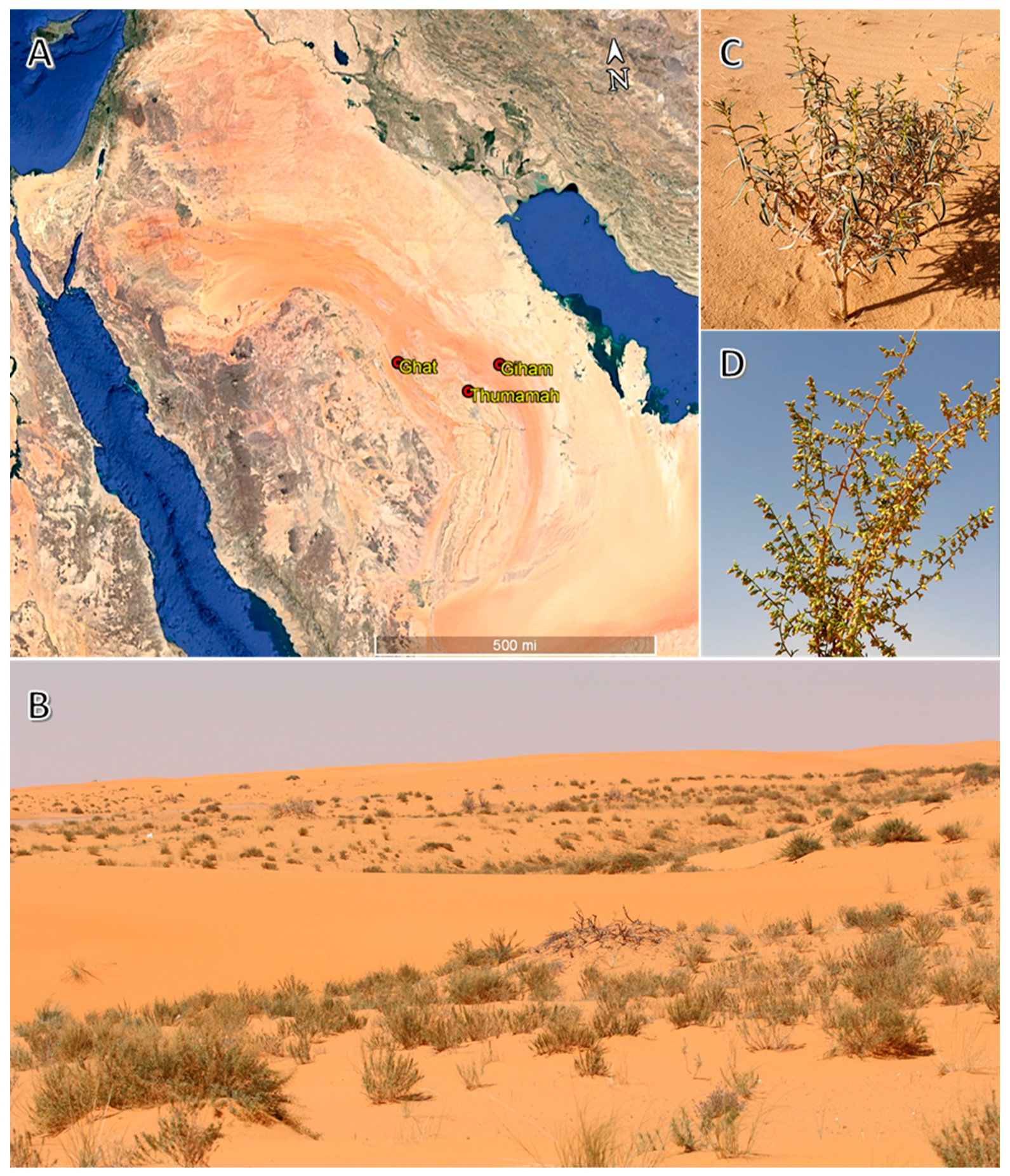
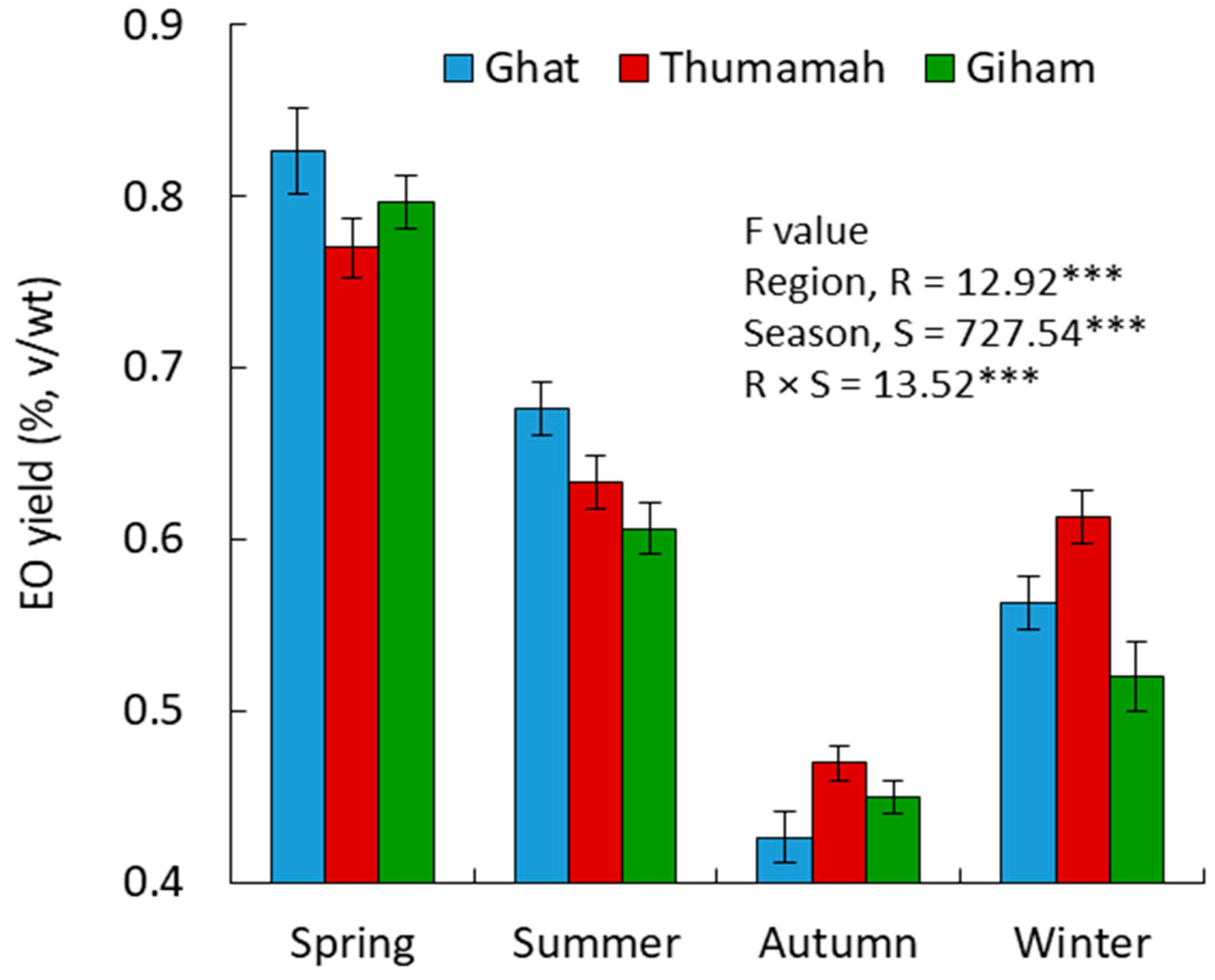
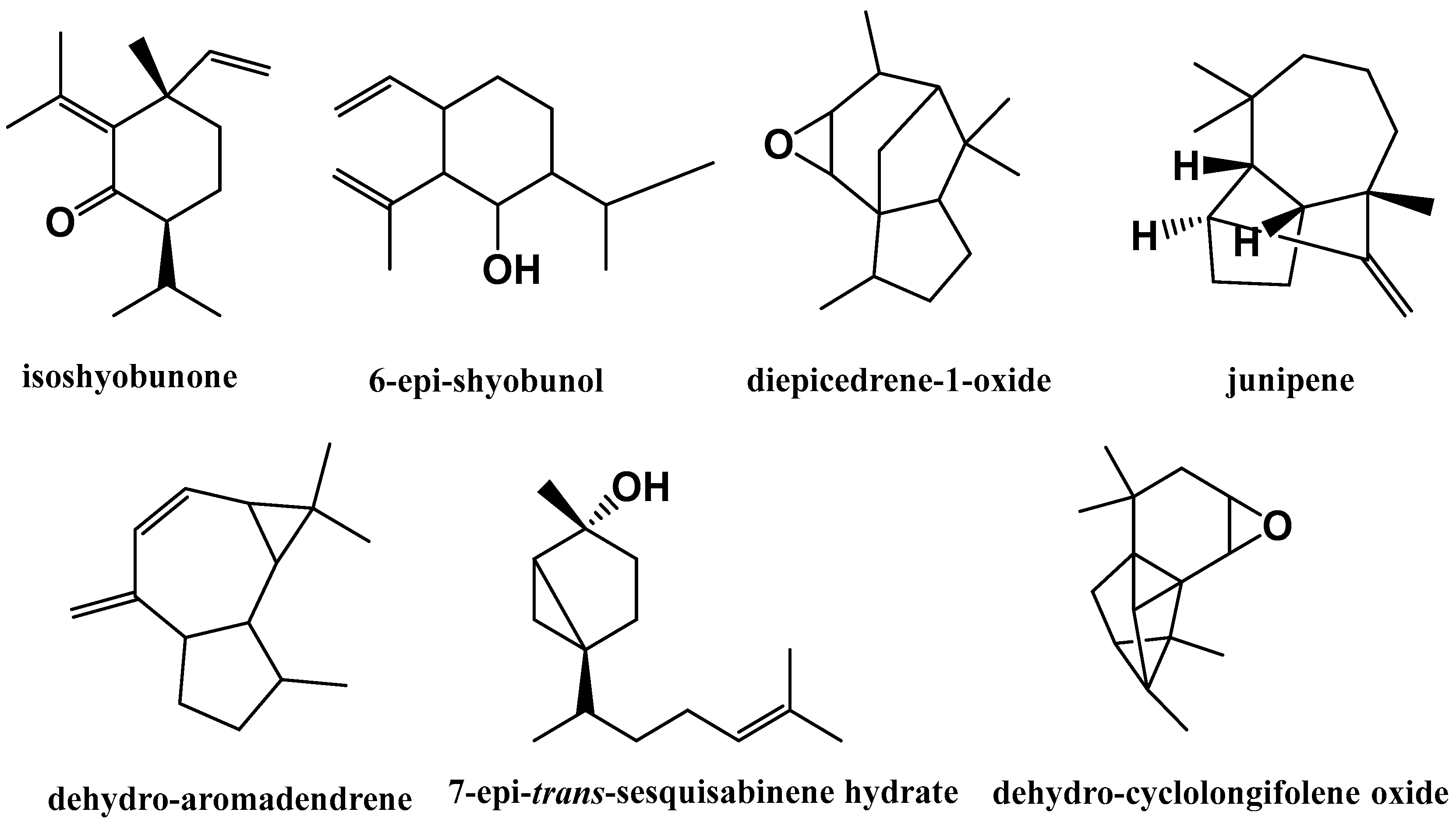
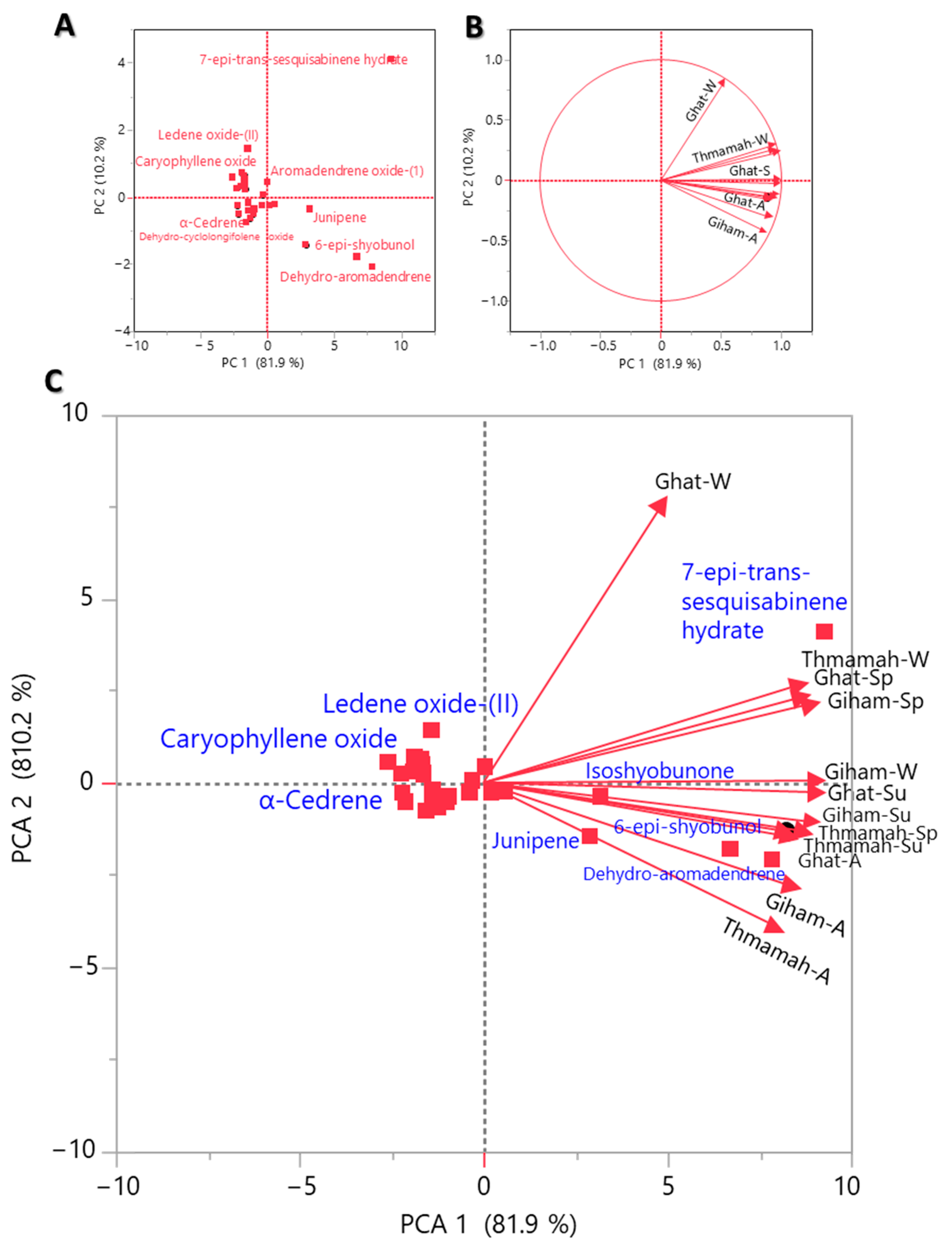
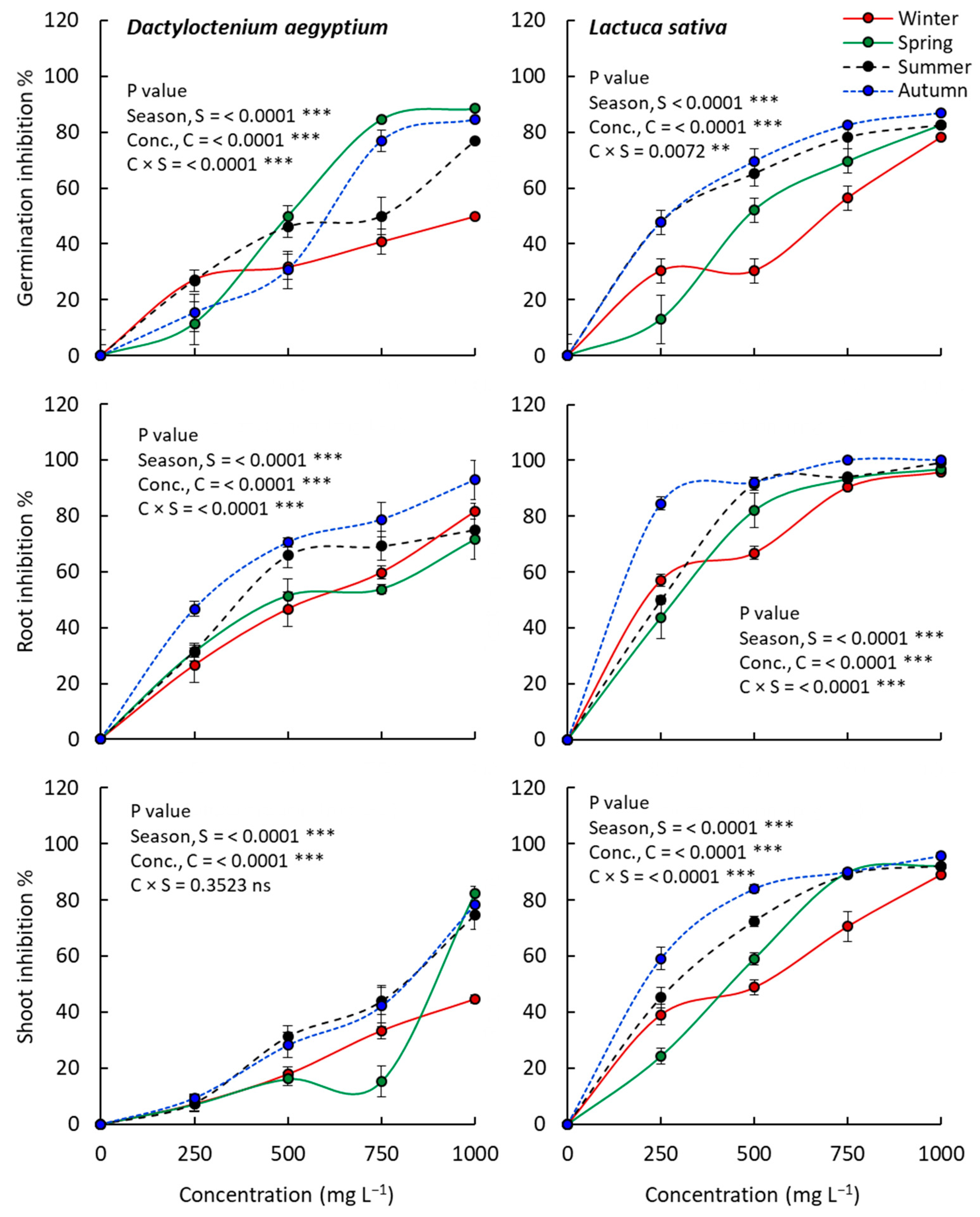
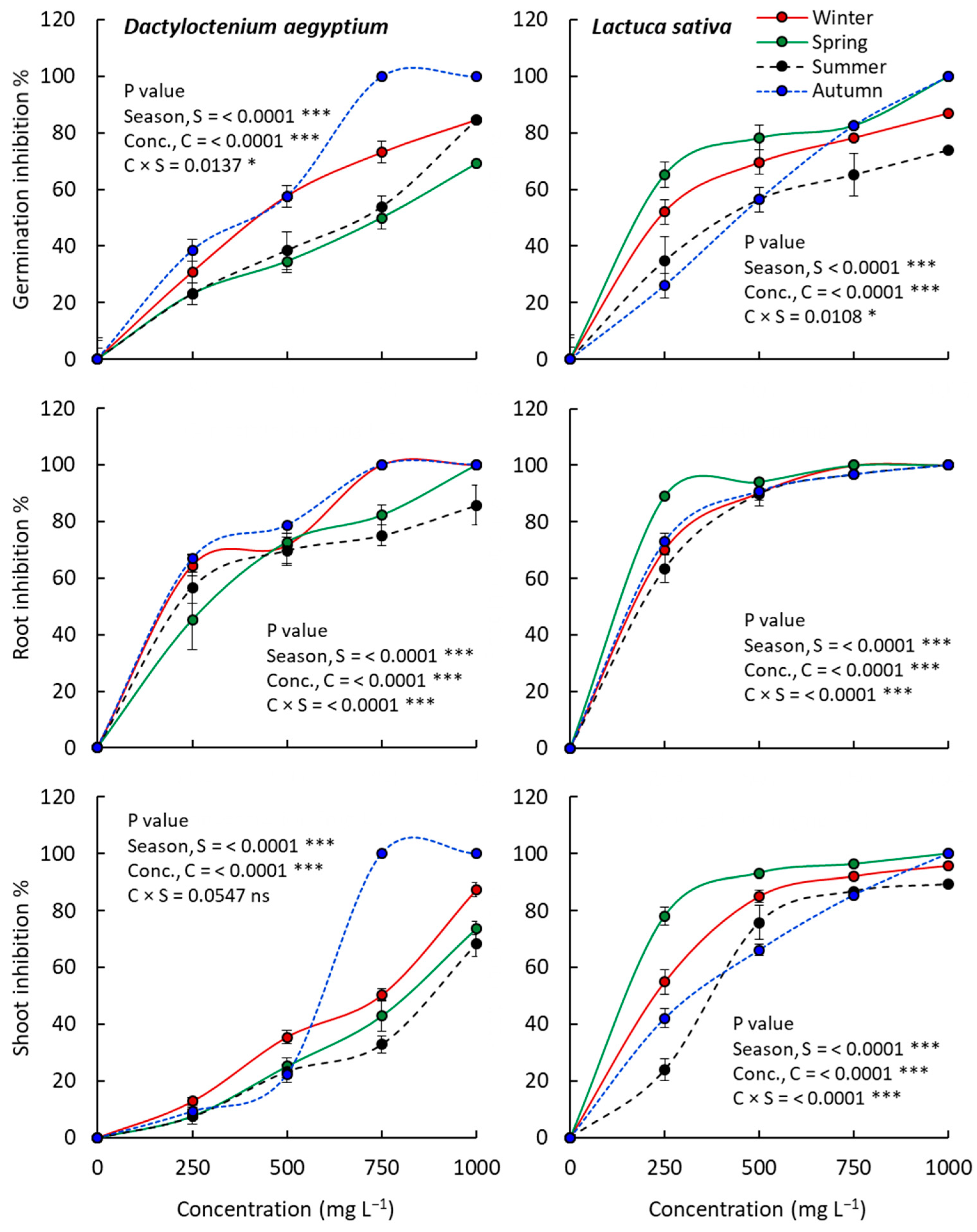
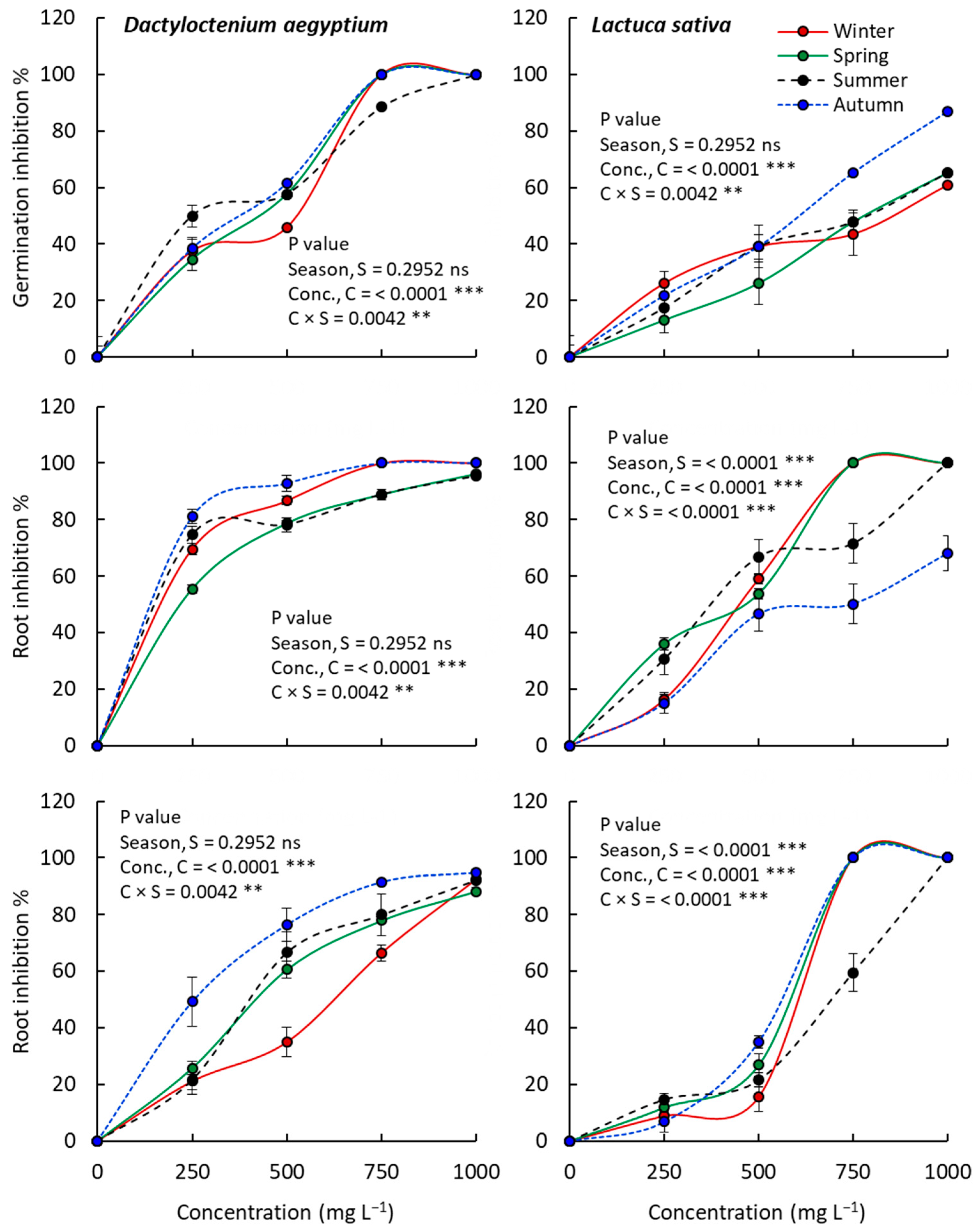
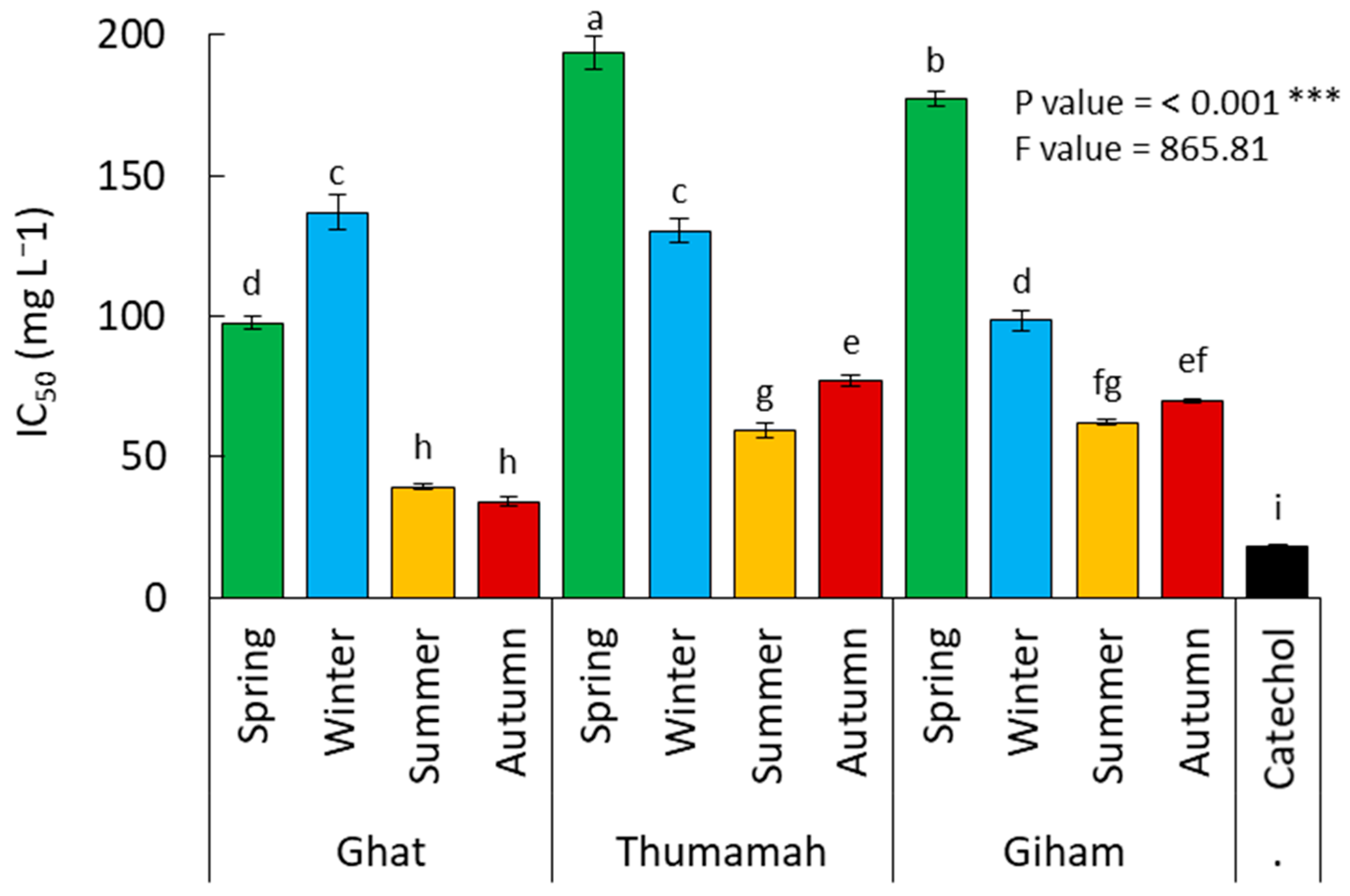
| Parameters | Regions | p-Value | F-Value | ||
|---|---|---|---|---|---|
| Ghat | Thumamah | Giham | |||
| Sand (%) | 96.86 ± 0.76 ab | 97.88 ± 0.26 a | 93.49 ± 5.12 b | 0.0826 ns | 3.89 |
| Silt (%) | 2.35 ± 0.66 a | 1.58 ± 0.36 a | 3.73 ± 2.96 a | 0.1636 ns | 2.49 |
| Clay (%) | 0.79 ± 0.58 a | 0.54 ± 0.11 a | 2.78 ± 2.16 a | 0.1255 ns | 2.99 |
| CaCO3 (%) | 23.01 ± 0.78 a | 19.82 ± 0.72 b | 18.62 ± 0.65 c | 0.0003 *** | 44.40 |
| pH | 8.08 ± 0.11 a | 8.02 ± 0.06 a | 8.07 ± 0.12 a | 0.3788 ns | 1.15 |
| EC (dS/m | 0.14 ± 0.01 a | 0.14 ± 0.02 a | 0.13 ± 0.02 a | 0.7703 ns | 0.27 |
| Na (mg/kg) | 6.53 ± 1.15 a | 6.13 ± 1.01 a | 5.00 ± 2.71 a | 0.7303 ns | 0.33 |
| K (mg/kg) | 7.33 ± 1.81 a | 8.10 ± 2.74 a | 8.68 ± 2.74 a | 0.7475 ns | 0.31 |
| OM (g/kg) | 0.96 ± 0.71 a | 0.39 ± 0.38 a | 1.47 ± 1.87 a | 0.1782 ns | 2.33 |
| Source | Sum of Squares | df | Mean Square | F-Value | p-Value |
|---|---|---|---|---|---|
| Regions (R) | 0.079 | 2 | 0.049 | 66.38 | <0.001 *** |
| Seasons (S) | 0.026 | 3 | 0.008 | 11.64 | 0.001 *** |
| R × S | 0.043 | 6 | 0.007 | 9.71 | <0.001 *** |
| No | Rt. 1 | KI 2 | Component Name | Concentration % 3 | |||
|---|---|---|---|---|---|---|---|
| Autumn | Winter | Spring | Summer | ||||
| Monoterpene hydrocarbons | |||||||
| 1 | 4.63 | 973 | β-Pinene | 0.08 ± 0.01 | - | - | 0.17 ± 0.01 |
| 2 | 7.01 | 1062 | γ-Terpinene | - | - | - | 0.31 ± 0.01 |
| 3 | 5.6 | 1026 | p-Cymenene | 0.05 ± 0.00 | - | - | - |
| Oxygenated Monoterpenes | |||||||
| 4 | 7.05 | 1098 | L-Linalool | - | - | - | - |
| 5 | 7.19 | 1101 | Hotrienol | 0.17 ± 0.00 | - | 3.25 ± 0.07 | 0.17 ± 0.00 |
| 6 | 9.1 | 1174 | 1,8-menthadien-4-ol | 0.88 ± 0.03 | - | 0.24 ± 0.01 | 0.88 ± 0.03 |
| 7 | 9.41 | 1177 | Myrtenal | 0.98 ± 0.04 | - | 0 | 0.98 ± 0.04 |
| 8 | 9.47 | 1183 | p-Cymen-8-ol | 0.14 ± 0.00 | - | 1.39 ± 0.06 | 0.14 ± 0.00 |
| 9 | 9.53 | 1189 | α-Terpineol | 0.15 ± 0.00 | - | 0 | 0.15 ± 0.00 |
| 10 | 10.1 | 1211 | α-Citronellol | 0.11 ± 0.00 | - | 0.08 ± 0.00 | 0.11 ± 0.00 |
| 11 | 10.2 | 1217 | 1-p-Menthen-9-al | 0.38 ± 0.02 | - | 0.16 ± 0.00 | 0.38 ± 0.02 |
| 12 | 10.4 | 1142 | cis-Verbenol | - | - | - | - |
| 13 | 10.8 | 1249 | trans-Geraniol | - | - | 0.33 ± 0.01 | - |
| 14 | 12.5 | 1282 | Piperitone | 1.21 ± 0.08 | 0.14 ± 0.00 | 0.33 ± 0.01 | 1.21 ± 0.08 |
| 15 | 13.1 | 1298 | Carvacrol | 0.52 ± 0.03 | - | 0.19 ± 0.00 | 0.52 ± 0.03 |
| Sesquiterpene hydrocarbons | |||||||
| 16 | 13.4 | 1335 | α-Elemene | 2.59 ± 0.15 | 0.43 ± 0.02 | 0.78 ± 0.03 | 2.16 ± 0.09 |
| 17 | 13.9 | 1351 | α-Cubebene | 2.25 ± 0.06 | 0.33 ± 0.01 | 0.70 ± 0.02 | 1.63 ± 0.07 |
| 18 | 14.1 | 1352 | α-Longipinene | 2.76 ± 0.08 | 0.21 ± 0.01 | 0.72 ± 0.01 | 1.92 ± 0.07 |
| 19 | 14.2 | 1373 | Isoledene | - | - | 0.06 ± 0.00 | - |
| 20 | 14.3 | 1375 | α-Ylangene | 0.14 ± 0.00 | - | 0.20 ± 0.01 | - |
| 21 | 14.5 | 1376 | α-Copaene | 0.71 ± 0.04 | - | 0.06 ± 0.00 | 0.25 ± 0.01 |
| 22 | 14.8 | 1409 | α-Gurjunene | 0.11 ± 0.00 | 0.18 ± 0.00 | 0.25 ± 0.01 | 0.51 ± 0.02 |
| 23 | 15 | 1410 | α-Cedrene | - | 0.19 ± 0.00 | 0.37 ± 0.01 | - |
| 24 | 15.2 | 1427 | trans-Caryophyllene | 2.52 ± 0.12 | 0.28 ± 0.01 | 1.81 ± 0.05 | 1.58 ± 0.04 |
| 25 | 15.4 | 1439 | Aromandendrene | 4.85 ± 0.15 | 1.25 ± 0.05 | 3.19 ± 0.09 | 3.94 ± 0.09 |
| 26 | 15.4 | 1442 | α-Guaiene | 0.69 ± 0.03 | - | 0.26 ± 0.01 | 0.53 ± 0.03 |
| 27 | 15.8 | 1462 | α-Humulene | 0.31 ± 0.01 | 0.26 ± 0.01 | 0.09 ± 0.00 | 0.38 ± 0.01 |
| 28 | 16.1 | 1466 | Dehydro-aromadendrene | 11.42 ± 0.25 | 0.85 ± 0.02 | 13.46 ± 0.23 | 12.30 ± 0.21 |
| 29 | 16.4 | 1481 | ar-Curcumene | 2.46 ± 0.09 | 0.36 ± 0.01 | 2.05 ± 0.11 | 3.28 ± 0.09 |
| 30 | 16.5 | 1486 | Germacrene D | 0.35 ± 0.01 | - | 0.20 ± 0.01 | 0.17 ± 0.00 |
| 31 | 16.5 | 1492 | Berkheyaradulene | 0.16 ± 0.00 | - | 0.23 ± 0.01 | - |
| 32 | 16.8 | 1499 | α-Muurolene | 0.69 ± 0.03 | 1.91 ± 0.07 | 0.65 ± 0.02 | 1.48 ± 0.07 |
| 33 | 17 | 1505 | α-Bulnesene | 3.87 ± 0.19 | 5.86 ± 0.10 | 3.21 ± 0.09 | 4.10 ± 0.14 |
| 34 | 18 | 1557 | Junipene | 5.94 ± 0.27 | 3.52 ± 0.09 | 6.32 ± 0.16 | 4.49 ± 0.18 |
| Oxygenated Sesquiterpenes | |||||||
| 35 | 13.3 | 1317 | Dehydro-cyclolongifolene oxide | 0.38 ± 0.01 | 1.56 ± 0.03 | 3.01 ± 0.06 | 6.57 ± 0.16 |
| 36 | 15.7 | 1456 | Aromadendrene oxide-(1) | 1.48 ± 0.06 | 4.69 ± 0.12 | 1.11 ± 0.05 | 1.81 ± 0.08 |
| 37 | 16.2 | 1480 | 6-Epishyobunone | 0.32 ± 0.01 | 0.39 ± 0.01 | 0.18 ± 0.00 | 0.17 ± 0.00 |
| 38 | 17.1 | 1517 | 6-epi-shyobunol | 10.28 ± 0.28 | 1.91 ± 0.05 | 9.70 ± 0.14 | 10.42 ± 0.23 |
| 39 | 17.3 | 1533 | trans-Nerolidol | 0.90 ± 0.03 | - | 0.12 ± 0.00 | 0.63 ± 0.01 |
| 40 | 17.5 | 1538 | 7-epi-trans-Sesquisabinene hydrate | 8.31 ± 0.12 | 25.07 ± 0.41 | 17.18 ± 0.28 | 12.76 ± 0.23 |
| 41 | 17.8 | 1554 | Diepicedrene-1-oxide | 3.28 ± 0.07 | 2.06 ± 0.04 | 2.11 ± 0.07 | 5.11 ± 0.10 |
| 42 | 18.3 | 1571 | Isoshyobunone | 4.08 ± 0.11 | 3.55 ± 0.09 | 3.60 ± 0.09 | 2.96 ± 0.05 |
| 43 | 18.4 | 1579 | (-)-Spathulenol | 0.81 ± 0.02 | 2.04 ± 0.05 | 1.56 ± 0.06 | 0.93 ± 0.02 |
| 44 | 18.5 | 1581 | Caryophyllene oxide | 1.00 ± 0.02 | 2.51 ± 0.07 | 2.31 ± 0.06 | 1.54 ± 0.04 |
| 45 | 18.7 | 1582 | Geranyl isovalerate | 1.81 ± 0.06 | 2.92 ± 0.09 | 1.66 ± 0.03 | 1.17 ± 0.05 |
| 46 | 18.7 | 1594 | Carotol | 0.85 ± 0.03 | 3.47 ± 0.09 | 2.33 ± 0.06 | 2.32 ± 0.08 |
| 47 | 19 | 1631 | Ledene oxide-(II) | 1.19 ± 0.06 | 8.95 ± 0.15 | 4.28 ± 0.09 | 0.69 ± 0.02 |
| 48 | 19.1 | 1632 | Alloaromadendrene oxide-(2) | 1.39 ± 0.04 | 1.30 ± 0.05 | 1.22 ± 0.04 | 0.80 ± 0.02 |
| 49 | 19.2 | 1634 | Longipinocarveol, trans- | 0.94 ± 0.03 | 0.64 ± 0.02 | - | 0.27 ± 0.01 |
| 50 | 19.4 | 1640 | .tau.-Cadinol | 0.10 ± 0.00 | 0.66 ± 0.02 | 0.32 ± 0.01 | 0.91 ± 0.02 |
| 51 | 19.5 | 1641 | Alloaromadendrene epoxide | 1.60 ± 0.05 | 0.71 ± 0.02 | 0.27 ± 0.01 | 0.28 ± 0.01 |
| 52 | 19.7 | 1646 | .tau.-Muurolol | 1.02 ± 0.04 | 1.48 ± 0.03 | 2.85 ± 0.06 | 1.15 ± 0.06 |
| 53 | 19.7 | 1654 | α-Cadinol | 0.35 ± 0.01 | 1.92 ± 0.04 | - | 0.93 ± 0.03 |
| 54 | 20 | 1668 | Ledene oxide-(I) | 0.21 ± 0.01 | 1.07 ± 0.03 | 0.33 ± 0.02 | 0.32 ± 0.01 |
| 55 | 20.2 | 1685 | α-Bisabolol | 0.75 ± 0.03 | 0.79 ± 0.02 | 0.33 ± 0.02 | 0.28 ± 0.01 |
| 56 | 20.8 | 1722 | Farnesol | 0.40 ± 0.02 | 2.09 ± 0.06 | 1.10 ± 0.04 | 0.62 ± 0.02 |
| 57 | 22 | 1725 | Isocalamendiol | 0.99 ± 0.02 | 1.80 ± 0.05 | 0.23 ± 0.01 | 0.22 ± 0.00 |
| 58 | 22.1 | 1845 | Hexahydrofarnesyl acetone | 0.49 ± 0.01 | 0.93 ± 0.03 | - | - |
| Diterpene hydrocarbons | |||||||
| 59 | 23.4 | 1931 | Stachene | 0.41 ± 0.02 | 0.55 ± 0.02 | - | - |
| Oxygenated Diterpenes | |||||||
| 60 | 24.3 | 2203 | trans-Geranylgeraniol | 0.17 ± 0.00 | 0.22 ± 0.01 | 0.07 ± 0.00 | |
| Others | |||||||
| 61 | 8.02 | 1137 | Nopinone | - | - | - | 0.35 ± 0.01 |
| 62 | 12 | 1253 | Chavicol | - | - | 0.11 ± 0.00 | - |
| 63 | 15.6 | 1444 | Citronellyl propionate | 2.61 ± 0.05 | 0.52 ± 0.01 | 1.37 ± 0.03 | 2.81 ± 0.05 |
| 64 | 23.1 | 1857 | Hexadeca-7,11 -dien-1-ol | 0.28 ± 0.01 | 0.19 ± 0.00 | - | - |
| Monoterpene hydrocarbons (MH) | 0.13 | - | - | 0.48 | |||
| Oxygenated Monoterpene (OM) | 4.54 | 0.14 | 5.97 | 4.2 | |||
| Sesquiterpene hydrocarbons (SH) | 41.82 | 15.63 | 34.61 | 38.72 | |||
| Oxygenated Sesquiterpenes (OS) | 42.93 | 72.51 | 55.8 | 52.86 | |||
| Diterpene hydrocarbons (DH) | 0.41 | 0.55 | - | - | |||
| Oxygenated Diterpene OD | 0.17 | 0.22 | 0.07 | - | |||
| Others | 2.89 | 0.71 | 1.48 | 3.16 | |||
| Total | 92.89 | 89.76 | 97.93 | 99.42 | |||
| No | Rt. 1 | KI 2 | Component Name | Concentrations (%) 3 | |||
|---|---|---|---|---|---|---|---|
| Autumn | Winter | Spring | Summer | ||||
| Monoterpene hydrocarbons | |||||||
| 1 | 3.83 | 920 | α-Pinene | 0.31 ± 0.02 | - | - | 0.23 ± 0.01 |
| 2 | 4.63 | 973 | β-Pinene | 1.60 ± 0.05 | 0.70 ± 0.02 | 0.86 ± 0.02 | 1.36 ± 0.03 |
| 3 | 5.93 | 1033 | dl-Limonene | - | - | 0.17 ± 0.01 | - |
| 4 | 6.77 | 1044 | E-β-Ocimene | 0.48 ± 0.03 | 0.18 ± 0.01 | 0.53 ± 0.03 | 0.37 ± 0.02 |
| 5 | 7.01 | 1062 | γ-Terpinene | - | - | - | 0.41 ± 0.01 |
| 6 | 5.6 | 1026 | p-Cymenene | 0.72 ± 0.05 | 0.32 ± 0.02 | 0.25 ± 0.01 | 0.78 ± 0.03 |
| Oxygenated Monoterpene | |||||||
| 7 | 4.89 | 991 | 2,3-Dehydro-1,8-cineole | - | - | 0.09 ± 0.00 | 0.25 ± 0.02 |
| 8 | 7.05 | 1098 | L-Linalool | 0.38 ± 0.02 | 0.19 ± 0.01 | - | 0.49 ± 0.02 |
| 9 | 7.19 | 1101 | Hotrienol | 0.49 ± 0.03 | 4.69 ± 0.11 | 1.55 ± 0.06 | 1.43 ± 0.05 |
| 10 | 8.25 | 1139 | trans-Pinocarveol | 0.37 ± 0.01 | 0.31 ± 0.02 | 0.08 ± 0.00 | 0.48 ± 0.02 |
| 11 | 8.34 | 1143 | 2-Bornanone | - | 0.14 ± 0.00 | - | - |
| 12 | 8.76 | 1162 | Pinocarvone | - | - | - | 0.22 ± 0.01 |
| 13 | 9.1 | 1174 | 1,8-menthadien-4-ol | 3.58 ± 0.14 | 0.86 ± 0.03 | 0.32 ± 0.02 | 2.57 ± 0.10 |
| 14 | 9.41 | 1177 | Myrtenal | 1.53 ± 0.07 | 0.63 ± 0.02 | - | 1.38 ± 0.06 |
| 15 | 9.47 | 1183 | p-Cymen-8-ol | - | 1.72 ± 0.08 | 0.73 ± 0.03 | - |
| 16 | 9.53 | 1189 | α-Terpineol | 1.12 ± 0.05 | 0.24 ± 0.01 | - | 1.81 ± 0.07 |
| 17 | 10.1 | 1211 | α-Citronellol | 0.40 ± 0.02 | - | - | 0.30 ± 0.01 |
| 18 | 10.2 | 1217 | 1-p-Menthen-9-al | 0.26 ± 0.01 | 0.22 ± 0.00 | 0.08 ± 0.00 | 0.36 ± 0.01 |
| 19 | 10.4 | 1142 | cis-Verbenol | 0.17 ± 0.01 | - | - | 0.21 ± 0.01 |
| 20 | 10.8 | 1249 | trans-Geraniol | - | 0.17 ± 0.00 | - | - |
| 21 | 12.5 | 1282 | Piperitone | 1.67 ± 0.09 | 0.53 ± 0.02 | 0.45 ± 0.02 | 1.26 ± 0.06 |
| 22 | 13.1 | 1298 | Carvacrol | 0.79 ± 0.02 | 0.26 ± 0.01 | 0.28 ± 0.01 | 0.68 ± 0.03 |
| Sesquiterpene hydrocarbons | |||||||
| 23 | 13.4 | 1335 | α-Elemene | 3.15 ± 0.08 | 1.49 ± 0.02 | 1.21 ± 0.05 | 2.46 ± 0.06 |
| 24 | 13.9 | 1351 | α-Cubebene | 2.62 ± 0.06 | 1.15 ± 0.03 | 0.92 ± 0.03 | 1.98 ± 0.05 |
| 25 | 14.1 | 1352 | α-Longipinene | 3.02 ± 0.03 | 0.62 ± 0.01 | 0.82 ± 0.05 | 2.13 ± 0.07 |
| 26 | 14.2 | 1373 | Isoledene | 0.46 ± 0.03 | - | - | 0.34 ± 0.01 |
| 27 | 14.3 | 1375 | α-Ylangene | - | - | 0.36 ± 0.01 | - |
| 28 | 14.5 | 1376 | α-Copaene | - | - | 0.11 ± 0.00 | - |
| 29 | 14.6 | 1407 | Isocaryophyllene | - | - | 0.20 ± 0.01 | - |
| 30 | 14.8 | 1409 | α-Gurjunene | 0.55 ± 0.02 | 0.19 ± 0.01 | 0.27 ± 0.01 | 0.46 ± 0.01 |
| 31 | 15 | 1410 | α-Cedrene | 3.28 ± 0.07 | 0.43 ± 0.02 | 0.61 ± 0.02 | - |
| 32 | 15.2 | 1427 | trans-Caryophyllene | 1.84 ± 0.08 | 1.26 ± 0.02 | 2.52 ± 0.07 | 1.62 ± 0.05 |
| 33 | 15.4 | 1439 | Aromandendrene | 2.68 ± 0.09 | 4.38 ± 0.19 | 3.25 ± 0.13 | 3.89 ± 0.08 |
| 34 | 15.4 | 1442 | α-Guaiene | 0.80 ± 0.03 | 0.37 ± 0.02 | 0.44 ± 0.02 | 0.50 ± 0.01 |
| 35 | 15.8 | 1462 | α-Humulene | 0.31 ± 0.01 | 0.18 ± 0.01 | - | 0.30 ± 0.01 |
| 36 | 16.1 | 1466 | Dehydro-aromadendrene | 10.85 ± 0.28 | 9.48 ± 0.26 | 14.96 ± 0.31 | 10.11 ± 0.20 |
| 37 | 16.4 | 1481 | ar-Curcumene | 2.05 ± 0.05 | 3.09 ± 0.10 | 2.28 ± 0.09 | 4.63 ± 0.14 |
| 38 | 16.5 | 1486 | Germacrene D | 0.34 ± 0.01 | 0.40 ± 0.02 | 0.32 ± 0.01 | 0.28 ± 0.01 |
| 39 | 16.5 | 1492 | Berkheyaradulene | - | 0.15 ± 0.00 | - | - |
| 40 | 16.8 | 1499 | α-Muurolene | 0.66 ± 0.02 | 1.68 ± 0.03 | 0.46 ± 0.02 | 1.44 ± 0.06 |
| 41 | 17 | 1505 | α-Bulnesene | 2.77 ± 0.06 | 2.27 ± 0.05 | 2.66 ± 0.12 | 3.45 ± 0.07 |
| 42 | 18 | 1557 | Junipene | 5.58 ± 0.11 | 7.53 ± 0.32 | 13.12 ± 0.26 | 4.47 ± 0.09 |
| Oxygenated Sesquiterpenes | |||||||
| 43 | 13.3 | 1317 | Dehydro-cyclolongifolene oxide | 8.99 ± 0.21 | 5.54 ± 0.10 | 4.14 ± 0.12 | 7.70 ± 0.15 |
| 44 | 15.7 | 1456 | Aromadendrene oxide-(1) | 1.48 ± 0.04 | 0.57 ± 0.01 | 1.92 ± 0.07 | 0.92 ± 0.03 |
| 45 | 16.2 | 1480 | 6-Epishyobunone | 0.29 ± 0.00 | 0.18 ± 0.00 | - | - |
| 46 | 17.1 | 1517 | 6-epi-shyobunol | 9.14 ± 0.11 | 9.82 ± 0.17 | 13.43 ± 0.21 | 9.80 ± 0.13 |
| 47 | 17.3 | 1533 | trans-Nerolidol | 0.91 ± 0.02 | 0.17 ± 0.00 | 0.26 ± 0.00 | 0.67 ± 0.01 |
| 48 | 17.5 | 1538 | 7-epi-trans-Sesquisabinene hydrate | 6.12 ± 0.13 | 20.37 ± 0.29 | 10.30 ± 0.26 | 10.34 ± 0.21 |
| 49 | 17.8 | 1554 | Diepicedrene-1-oxide | 2.32 ± 0.03 | 2.53 ± 0.05 | 3.21 ± 0.08 | 4.16 ± 0.07 |
| 50 | 18.3 | 1571 | Isoshyobunone | 4.15 ± 0.09 | 2.87 ± 0.08 | 2.35 ± 0.09 | 0.42 ± 0.02 |
| 51 | 18.4 | 1579 | (-)-Spathulenol | 1.25 ± 0.06 | 0.81 ± 0.02 | - | 2.04 ± 0.05 |
| 52 | 18.5 | 1581 | Caryophyllene oxide | 0.51 ± 0.01 | 2.04 ± 0.04 | 1.08 ± 0.02 | 2.00 ± 0.06 |
| 53 | 18.7 | 1582 | Geranyl isovalerate | 1.74 ± 0.04 | 0.83 ± 0.02 | 0.78 ± 0.01 | 0.61 ± 0.01 |
| 54 | 18.7 | 1594 | Carotol | 0.42 ± 0.01 | 0.58 ± 0.01 | 1.07 ± 0.04 | 0.39 ± 0.01 |
| 55 | 19 | 1631 | Ledene oxide-(II) | 1.47 ± 0.03 | 0.83 ± 0.03 | 1.77 ± 0.05 | 0.61 ± 0.02 |
| 56 | 19.1 | 1632 | Alloaromadendrene oxide-(2) | 0.77 ± 0.02 | 0.29 ± 0.01 | 0.27 ± 0.01 | 0.21 ± 0.00 |
| 57 | 19.2 | 1634 | Longipinocarveol, trans- | 0 | 0.19 ± 0.00 | 0.15 ± 0.00 | 0.57 ± 0.02 |
| 58 | 19.4 | 1640 | .tau.-Cadinol | 0.29 ± 0.01 | 0.36 ± 0.01 | 0.09 ± 0.00 | 0.59 ± 0.02 |
| 59 | 19.5 | 1641 | alloaromadendrene epoxide | 0.26 ± 0.01 | 0.54 ± 0.01 | 0.18 ± 0.00 | 0.37 ± 0.01 |
| 60 | 19.7 | 1646 | .tau.-Muurolol | 0.85 ± 0.03 | 0.83 ± 0.02 | 5.41 ± 0.09 | 0.24 ± 0.01 |
| 61 | 19.7 | 1654 | α-Cadinol | 0.28 ± 0.01 | 1.22 ± 0.03 | 1.11 ± 0.03 | 0.69 ± 0.01 |
| 62 | 20 | 1668 | Ledene oxide-(I) | 0.17 ± 0.00 | 0.63 ± 0.02 | 0.07 ± 0.00 | 0.29 ± 0.01 |
| 63 | 20.2 | 1685 | α-Bisabolol | 0 | 0.26 ± 0.01 | 0.10 ± 0.00 | 0.21 ± 0.01 |
| 64 | 20.8 | 1722 | Farnesol | 0.20 ± 0.00 | 0.45 ± 0.02 | 0.41 ± 0.01 | 0.32 ± 0.01 |
| 65 | 22 | 1725 | Isocalamendiol | - | 0.2 ± 0.01 | - | - |
| Others | |||||||
| 66 | 12 | 1253 | Chavicol | 0.26 ± 0.01 | 0.15 ± 0.01 | 0.11 ± 0.00 | - |
| 67 | 15.6 | 1444 | Citronellyl propionate | 2.60 ± 0.07 | 1.73 ± 0.03 | 1.41 ± 0.04 | 3.04 ± 0.06 |
| Monoterpene hydrocarbons (MH) | 3.11 | 1.2 | 1.81 | 3.15 | |||
| Oxygenated Monoterpene (OM) | 10.76 | 9.96 | 3.58 | 11.44 | |||
| Sesquiterpene hydrocarbons (SH) | 40.96 | 34.67 | 44.51 | 38.06 | |||
| Oxygenated Sesquiterpenes (OS) | 41.61 | 52.12 | 48.1 | 43.15 | |||
| Others | 2.86 | 1.88 | 1.52 | 3.04 | |||
| Total | 99.3 | 99.83 | 99.52 | 98.84 | |||
| No | Rt. 1 | KI 2 | Component Name | Concentration (%) 3 | |||
|---|---|---|---|---|---|---|---|
| Autumn | Winter | Spring | Summer | ||||
| Monoterpene hydrocarbons | |||||||
| 1 | 3.83 | 920 | α-Pinene | - | 0.30 ± 0.01 | 0.29 ± 0.01 | - |
| 2 | 4.63 | 973 | β-Pinene | 0.32 ± 0.01 | 1.47 ± 0.04 | 1.39 ± 0.04 | 0.68 ± 0.02 |
| 3 | 6.77 | 1044 | E-β-Ocimene | 0.17 ± 0.01 | 0.31 ± 0.02 | 0.25 | 0.28 ± 0.01 |
| 4 | 7.01 | 1062 | γ-Terpinene | 0.21 ± 0.01 | - | - | 0.38 ± 0.02 |
| 5 | 5.6 | 1026 | p-Cymenene | 0.27 ± 0.02 | 0.60 ± 0.04 | 0.56 ± 0.03 | 0.32 ± 0.02 |
| Oxygenated Monoterpene | |||||||
| 6 | 7.05 | 1098 | L-Linalool | 0.30 ± 0.01 | 0.28 ± 0.01 | 0.17 ± 0.01 | 0.14 ± 0.00 |
| 7 | 7.19 | 1101 | Hotrienol | 0.91 ± 0.01 | 1.72 ± 0.05 | 1.56 ± 0.04 | 1.52 ± 0.03 |
| 8 | 8.25 | 1139 | trans-Pinocarveol | 0.34 ± 0.02 | 0.35 ± 0.02 | 0.34 ± 0.01 | - |
| 9 | 8.34 | 1143 | 2-Bornanone | - | 0.14 ± 0.00 | 0.14 ± 0.01 | - |
| 10 | 8.76 | 1162 | Pinocarvone | - | 0.15 ± 0.00 | 0.17 ± 0.01 | - |
| 11 | 9.1 | 1174 | 1,8-menthadien-4-ol | 3.99 ± 0.13 | 0.79 ± 0.01 | 0.69 ± 0.03 | 1.43 ± 0.09 |
| 12 | 9.41 | 1177 | Myrtenal | 2.36 ± 0.09 | 0.67 ± 0.03 | 0.40 ± 0.01 | 0.70 ± 0.05 |
| 13 | 9.47 | 1183 | p-Cymen-8-ol | 1.41 ± 0.04 | 1.59 ± 0.06 | 0.67 ± 0.02 | 0.91 ± 0.02 |
| 14 | 9.53 | 1189 | α-Terpineol | 0.42 ± 0.02 | 0.31 ± 0.01 | 0.66 ± 0.02 | 0.14 ± 0.00 |
| 15 | 10.1 | 1211 | α-Citronellol | - | 0.16 ± 0.01 | - | - |
| 16 | 10.2 | 1217 | 1-p-Menthen-9-al | - | - | - | 0.12 ± 0.00 |
| 17 | 10.4 | 1142 | cis-Verbenol | - | - | - | 0.14 ± 0.00 |
| 18 | 10.8 | 1249 | trans-Geraniol | 0.18 ± 0.00 | - | - | 0.21 ± 0.01 |
| 19 | 12.5 | 1282 | Piperitone | 1.69 ± 0.08 | 0.89 ± 0.03 | 0.73 ± 0.03 | 1.07 ± 0.04 |
| 20 | 13.1 | 1298 | Carvacrol | 0.48 ± 0.03 | 0.35 | 0.32 ± 0.01 | 0.77 ± 0.02 |
| Sesquiterpene hydrocarbons | |||||||
| 21 | 13.4 | 1335 | α-Elemene | 2.64 ± 0.06 | 2.21 ± 0.05 | 1.68 ± 0.04 | 2.33 ± 0.03 |
| 22 | 13.9 | 1351 | α-Cubebene | 2.39 ± 0.06 | 1.50 ± 0.04 | 1.31 ± 0.05 | 1.93 ± 0.08 |
| 23 | 14.1 | 1352 | α-Longipinene | 2.92 ± 0.08 | 0.79 ± 0.02 | 0.90 ± 0.02 | 2.85 ± 0.07 |
| 24 | 14.2 | 1373 | Isoledene | 0.42 ± 0.02 | - | - | - |
| 25 | 14.3 | 1375 | α-Ylangene | 0.47 ± 0.02 | - | - | 0.14 ± 0.00 |
| 26 | 14.8 | 1409 | α-Gurjunene | - | 0.19 ± 0.00 | 0.25 ± 0.01 | 0.51 ± 0.01 |
| 27 | 15 | 1410 | α-Cedrene | 3.74 ± 0.09 | 0.70 ± 0.01 | 0.49 ± 0.02 | 0.39 ± 0.02 |
| 28 | 15.2 | 1427 | trans-Caryophyllene | 1.62 ± 0.05 | 1.08 ± 0.02 | 1.83 ± 0.05 | 1.74 ± 0.03 |
| 29 | 15.4 | 1439 | Aromandendrene | 2.77 ± 0.07 | 3.34 ± 0.06 | 4.00 ± 0.11 | 5.05 ± 0.09 |
| 30 | 15.4 | 1442 | α-Guaiene | 0.81 ± 0.02 | 0.50 ± 0.03 | 0.46 ± 0.02 | 0.55 ± 0.02 |
| 31 | 15.8 | 1462 | α-Humulene | 0.41 ± 0.01 | - | - | 0.37 ± 0.01 |
| 32 | 16.1 | 1466 | Dehydro-aromadendrene | 9.77 ± 0.18 | 11.19 ± 0.16 | 10.64 ± 0.24 | 11.27 ± 0.21 |
| 33 | 16.4 | 1481 | ar-Curcumene | 2.05 ± 0.05 | 3.11 ± 0.09 | 2.49 ± 0.07 | 3.17 ± 0.08 |
| 34 | 16.5 | 1486 | Germacrene D | 0.28 ± 0.02 | 0.30 ± 0.02 | 0.16 ± 0.01 | 0.47 ± 0.02 |
| 35 | 16.5 | 1492 | Berkheyaradulene | 0.84 ± 0.02 | 0.23 ± 0.01 | 0.15 ± 0.00 | 0.12 ± 0.00 |
| 36 | 16.8 | 1499 | α-Muurolene | - | 1.26 ± 0.07 | 1.19 ± 0.03 | 1.47 ± 0.08 |
| 37 | 17 | 1505 | α-Bulnesene | 2.43 ± 0.07 | 2.36 ± 0.06 | 2.66 ± 0.08 | 3.27 ± 0.09 |
| 38 | 18 | 1557 | Junipene | 5.23 ± 0.06 | 8.76 ± 0.17 | 7.20 ± 0.19 | 4.48 ± 0.07 |
| Oxygenated Sesquiterpenes | |||||||
| 39 | 13.3 | 1317 | Dehydro-cyclolongifolene oxide | 7.87 ± 0.13 | 8.27 ± 0.14 | 6.77 ± 0.11 | 6.92 ± 0.09 |
| 40 | 15.7 | 1456 | Aromadendrene oxide-(1) | 1.46 ± 0.08 | 0.75 ± 0.02 | 0.75 ± 0.01 | 1.89 ± 0.19 |
| 41 | 16.2 | 1480 | 6-Epishyobunone | 0.15 ± 0.00 | 0.30 ± 0.01 | 0.18 ± 0.00 | - |
| 42 | 17.1 | 1517 | 6-epi-shyobunol | 10.07 ± 0.17 | 9.58 ± 0.19 | 9.59 ± 0.15 | 9.88 ± 0.12 |
| 43 | 17.3 | 1533 | trans-Nerolidol | 0.67 ± 0.02 | 0.22 ± 0.01 | 0.20 ± 0.00 | 0.44 ± 0.02 |
| 44 | 17.5 | 1538 | 7-epi-trans-Sesquisabinene hydrate | 7.89 ± 0.11 | 13.87 ± 0.32 | 19.01 ± 0.36 | 10.45 ± 0.25 |
| 45 | 17.8 | 1554 | Diepicedrene-1-oxide | 3.38 ± 0.06 | 3.18 ± 0.08 | 3.03 ± 0.06 | 3.96 ± 0.06 |
| 46 | 18.3 | 1571 | Isoshyobunone | 3.78 ± 0.10 | 3.08 ± 0.09 | 2.79 ± 0.07 | 0.49 ± 0.01 |
| 47 | 18.4 | 1579 | (-)-Spathulenol | 0.88 ± 0.01 | 1.11 ± 0.06 | 0.99 ± 0.02 | 1.86 ± 0.08 |
| 48 | 18.5 | 1581 | Caryophyllene oxide | 0.70 ± 0.01 | 1.77 ± 0.07 | 1.63 ± 0.06 | 0.94 ± 0.03 |
| 49 | 18.7 | 1582 | Geranyl isovalerate | 1.85 ± 0.05 | 2.33 ± 0.04 | 0.98 ± 0.02 | 1.41 ± 0.06 |
| 50 | 18.7 | 1594 | Carotol | 0.82 ± 0.02 | 1.50 ± 0.05 | 0.99 ± 0.07 | 1.52 ± 0.04 |
| 51 | 19 | 1631 | Ledene oxide-(II) | 1.92 ± 0.07 | - | 1.85 ± 0.06 | 1.39 ± 0.05 |
| 52 | 19.1 | 1632 | Alloaromadendrene oxide-(2) | 0.57 ± 0.02 | 0.65 ± 0.03 | 0.59 ± 0.02 | 2.12 ± 0.07 |
| 53 | 19.2 | 1634 | Longipinocarveol, trans- | 0.33 ± 0.01 | 0.17 ± 0.00 | 0.25 ± 0.01 | 0.36 ± 0.01 |
| 54 | 19.4 | 1640 | .tau.-Cadinol | 0.19 ± 0.01 | 0.17 ± 0.00 | 0.22 ± 0.01 | 0.16 ± 0.00 |
| 55 | 19.5 | 1641 | alloaromadendrene epoxide | 0.94 ± 0.02 | - | 0.32 ± 0.01 | 1.14 ± 0.03 |
| 56 | 19.7 | 1646 | /.tau.-Muurolol | 1.22 ± 0.04 | 0.73 ± 0.01 | 1.44 ± 0.03 | 1.68 ± 0.04 |
| 57 | 19.7 | 1654 | α-Cadinol | 0.43 ± 0.01 | 1.01 ± 0.02 | 1.07 ± 0.03 | 0.91 ± 0.02 |
| 58 | 20 | 1668 | Ledene oxide-(I) | 0.27 ± 0.01 | 0.42 ± 0.01 | 0.47 ± 0.02 | 0.35 ± 0.01 |
| 59 | 20.2 | 1685 | α-Bisabolol | - | 0.18 ± 0.00 | 0.26 ± 0.02 | 0.34 ± 0.01 |
| 60 | 20.8 | 1722 | Farnesol | 0.30 ± 0.02 | 0.38 ± 0.02 | 0.51 ± 0.02 | 0.35 ± 0.02 |
| 61 | 22 | 1725 | Isocalamendiol | - | 0.30 ± 0.01 | 0.20 ± 0.00 | 0.12 ± 0.00 |
| Others | |||||||
| 62 | 12 | 1253 | Chavicol | 0.21 ± 0.01 | - | - | - |
| 63 | 15.6 | 1444 | Citronellyl propionate | 2.17 ± 0.05 | 1.94 ± 0.04 | 1.46 ± 0.04 | 2.25 ± 0.06 |
| Monoterpene hydrocarbons (MH) | 0.97 | 2.68 | 2.49 | 1.66 | |||
| Oxygenated Monoterpene (OM) | 12.08 | 7.4 | 5.85 | 7.15 | |||
| Sesquiterpene hydrocarbons (SH) | 38.79 | 37.52 | 35.41 | 40.11 | |||
| Oxygenated Sesquiterpenes (OS) | 45.69 | 49.97 | 54.09 | 48.68 | |||
| Others | 2.38 | 1.94 | 1.46 | 2.25 | |||
| Total | 99.91 | 99.51 | 99.3 | 99.85 | |||
Disclaimer/Publisher’s Note: The statements, opinions and data contained in all publications are solely those of the individual author(s) and contributor(s) and not of MDPI and/or the editor(s). MDPI and/or the editor(s) disclaim responsibility for any injury to people or property resulting from any ideas, methods, instructions or products referred to in the content. |
© 2023 by the authors. Licensee MDPI, Basel, Switzerland. This article is an open access article distributed under the terms and conditions of the Creative Commons Attribution (CC BY) license (https://creativecommons.org/licenses/by/4.0/).
Share and Cite
Abd-ElGawad, A.M.; Assaeed, A.M.; Al-Rowaily, S.L.; Alshahri, M.S.; Bonanomi, G.; Elshamy, A.I. Influence of Season and Habitat on the Essential Oils Composition, Allelopathy, and Antioxidant Activities of Artemisia monosperma Delile. Separations 2023, 10, 263. https://doi.org/10.3390/separations10040263
Abd-ElGawad AM, Assaeed AM, Al-Rowaily SL, Alshahri MS, Bonanomi G, Elshamy AI. Influence of Season and Habitat on the Essential Oils Composition, Allelopathy, and Antioxidant Activities of Artemisia monosperma Delile. Separations. 2023; 10(4):263. https://doi.org/10.3390/separations10040263
Chicago/Turabian StyleAbd-ElGawad, Ahmed M., Abdulaziz M. Assaeed, Saud L. Al-Rowaily, Mohamed S. Alshahri, Giuliano Bonanomi, and Abdelsamed I. Elshamy. 2023. "Influence of Season and Habitat on the Essential Oils Composition, Allelopathy, and Antioxidant Activities of Artemisia monosperma Delile" Separations 10, no. 4: 263. https://doi.org/10.3390/separations10040263
APA StyleAbd-ElGawad, A. M., Assaeed, A. M., Al-Rowaily, S. L., Alshahri, M. S., Bonanomi, G., & Elshamy, A. I. (2023). Influence of Season and Habitat on the Essential Oils Composition, Allelopathy, and Antioxidant Activities of Artemisia monosperma Delile. Separations, 10(4), 263. https://doi.org/10.3390/separations10040263










